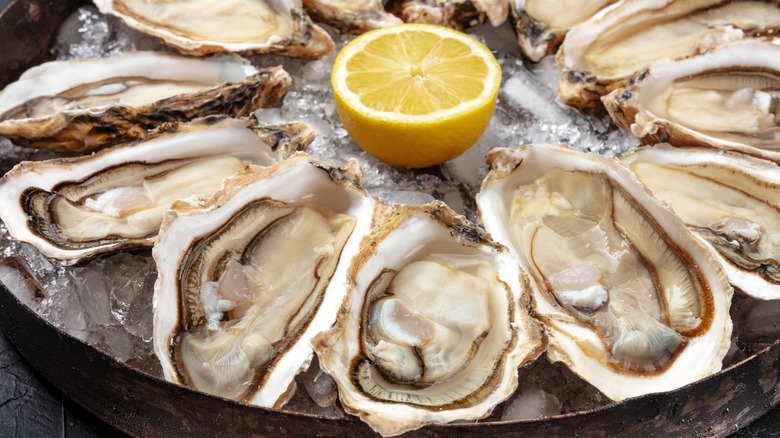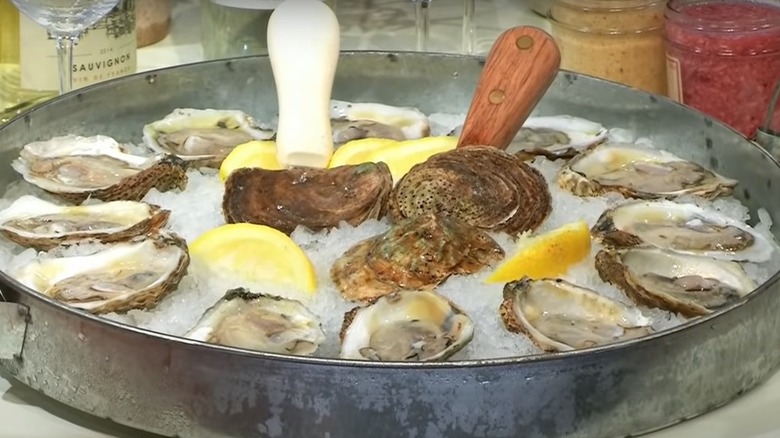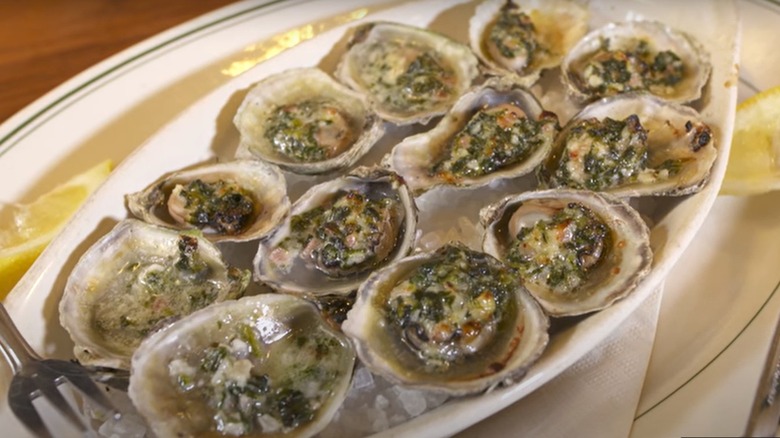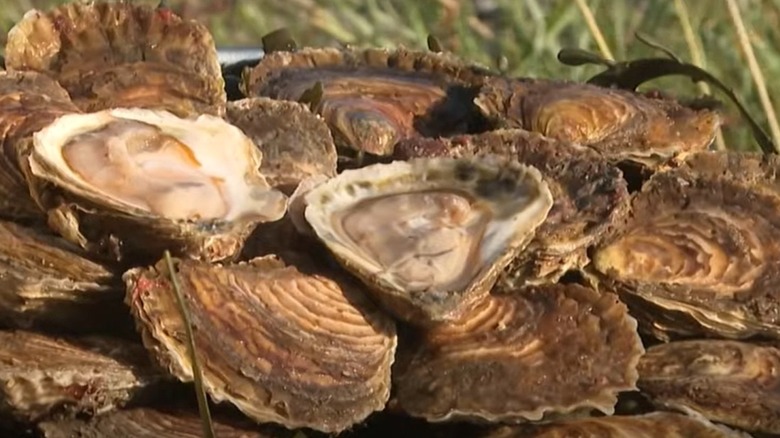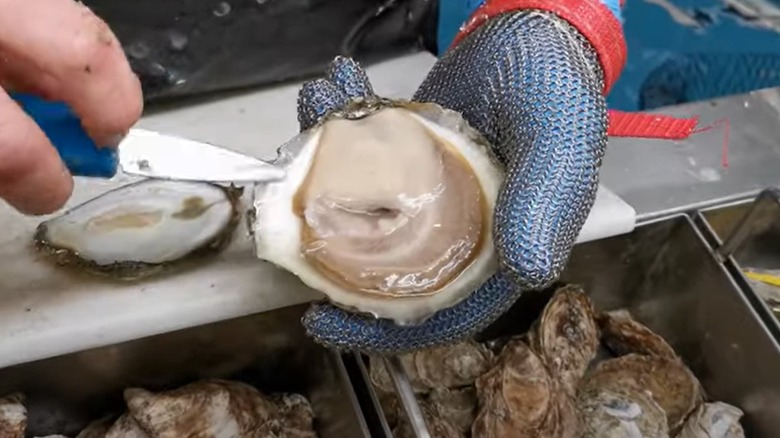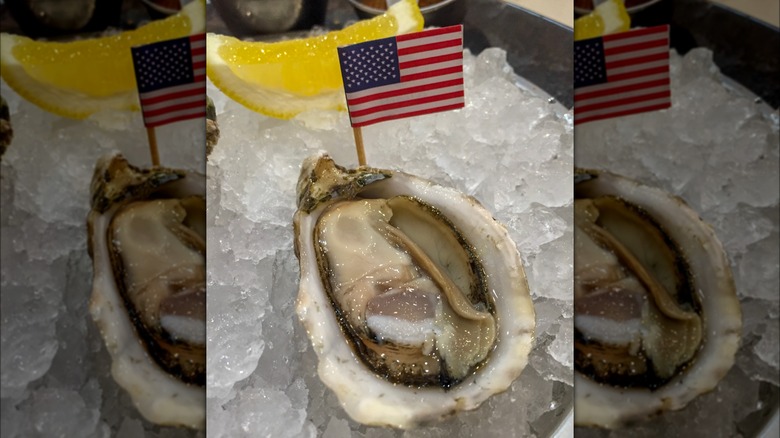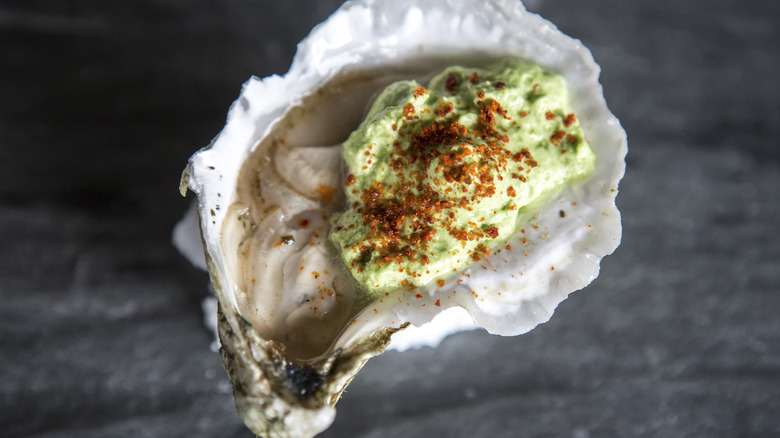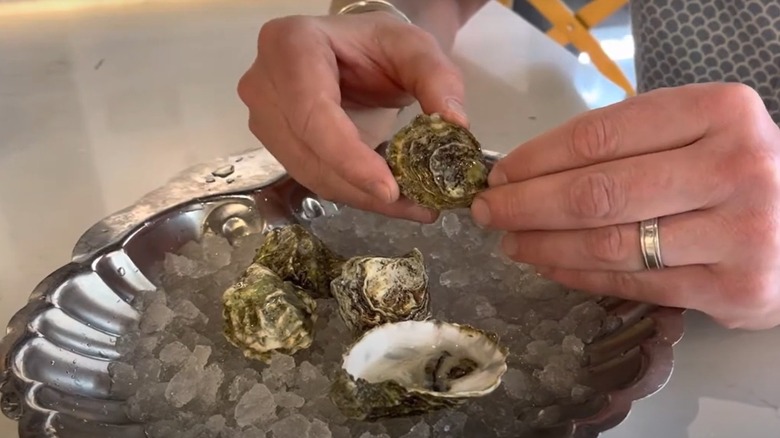7 Types Of Oysters And How To Eat Them, According To A Seafood Expert
Whether you consider yourself a seafood connoisseur or only occasionally order oysters when you're out at a restaurant, knowing how to eat them properly is essential. Between the number of different oyster species and the various environments in which they are raised, different farming methods, and branding differences, a nearly infinite number of oyster types are waiting to be tried. Each variety offers a unique flavor profile and texture, which can impact the ideal way to enjoy it.
We spoke with Franklin Becker, a chef and the owner/partner of Point Seven and The Press Club Grill, for his expert advice on the best way to eat some of the most popular oyster types. In the next few sections, we'll share his tips and a little background information about each type of oyster and where it comes from. After reading his suggestions, don't be surprised if you start to wonder which wines are best to pair with oysters when you throw your oyster party.
Bluepoint
Franklin Becker describes Bluepoints as "a must-have introductory oyster." If you're getting your feet wet, so to speak, by trying different oyster varieties, they can be the perfect place to start. According to Becker, the Bluepoint's "middle-of-the-road minerality and salinity makes them perfect for everything from eating naked to stuffing a la Rockefeller."
Bluepoints rose to fame about 200 years ago. Originally harvested from Long Island's Great South Bay, near Blue Point town, New Yorkers couldn't get enough of these oysters. So, it didn't take long for all the Bluepoint oysters in the bay to be consumed. Fortunately, it didn't take long for more oysters to be discovered in the Great South Bay, and they were quickly marketed as Bluepoints. Today, Bluepoint oysters continue to be seeded along the bottom of the Great South Bay before being dredged up and sold after a few years. Some of the oysters are harvested along the Long Island side of the bay, while others are harvested from the Connecticut side.
Olympia
"I like Olympia oysters," says Franklin Becker. He describes this variety as "creamy, slightly metallic and oceanic." While you could prepare Olympia oysters in other ways, according to Becker, less is more with this variety. He explains that the oysters "are best eaten with nothing or a light squeeze of lemon."
Unlike many other types of oysters transported from other countries, Olympia oysters are native to America. They can be found along the West Coast, as far south as Mexico, and as far north as southern Alaska. Olympia oysters may have shells of different colors, with some shells being more white and others having a purple hue, potentially with yellow or brown stripes. The shape of each oyster's shell can also vary; it often depends on the surface where the oyster was growing. Unfortunately, many of the bays, tidal channels, and sounds where Olympia oysters grow have become uninhabitable because of development and water pollution.
European Flat
European Flat oysters are a relative of the Olympia oysters found along the West Coast of the United States. However, this variety is native to Europe. They can be found along the coast of Europe, sprawling between the Mediterranean and the North Sea. These oysters grow slower than many other varieties, taking as many as five years to grow large enough to enjoy.
One of the most popular places where European Flat oysters are cultivated is near the town of Yerseke in the Netherlands. The waters off the town are often viewed as ideal for growing oysters, making European Flats from Yerseke among the best of the best. You can also find European Flats from Languedoc, a province in southern France. Franklin Becker recommends trying this variety if you're ever in the area, saying, "The European flat oyster from Languedoc is saltier than the Belon oysters of Maine and fantastic with lemon."
Belon
If you've never tried a Belon oyster before, Franklin Becker describes them as "creamy flat and round with high minerality and middle-of-the-road salinity." As for the best way to enjoy them, Becker says they are "Perfect eaten raw with lemon."
Belons, which are a type of European Flat oysters, were originally only found in France's Belon River. However, today, Belon oysters can also be found along the coast of Maine, even though some purists insist that the term "Belon" can only refer to oysters harvested directly from the river in France. The reason there are Belons here in North America can be traced back to the 1950s. During this time, scientists were trying to find an additional growing location for the oysters and transported several to the waters of Maine. However, at least initially, their efforts proved futile, and the group gave up on their idea. Over 20 years later, the previous work paid off, and several Belon oysters were found in the rivers and other waterways around Maine. If you're making a special trip to try a Maine lobster roll, pick up some Belon oysters while you're at it.
Kusshi
Hailing from Vancouver Island's east coast, Kusshi oysters are another popular pick. According to seafood expert Franklin Becker, the oysters have "a melon and cucumber-like taste with little salinity." Becker also advises that Kusshi oysters are "great with ponzu sauce and grilled."
A special growing technique is used when cultivating these oysters. They are suspended in trays and placed far beneath the water's surface in Deep Bay, located on the east coast of Vancouver Island. They are then continuously tumbled to ensure the fully developed oysters have a deep cup and a strong shell. The tumbling process also gives these oysters a smoother and sleeker shell than many other varieties. In addition, this technique ensures that, despite their smaller size, the oysters will use their energy to make more meat rather than increase the size of their shells. Because of this technique, kusshi oysters are known for having plumper pieces of meat for individuals to enjoy.
Wellfleet
Next time you're craving oysters, consider ordering some Wellfleets. Named for the town of Wellfleet on Cape Cod, Massachusetts, these oysters are among the most popular varieties in the U.S. and around the world. You can find both farmed and wild variations of Wellfleets online, in a store, or at a restaurant.
Franklin Becker highlights multiple uses for these oysters, which he describes as "sweet and plump with very high salinity." He explains, "They are the perfect oyster to fry." And, when preparing this oyster, Becker recommends dipping them "in a tartare sauce or enjoy[ing them] raw with mignonette." The high levels of nutrients found in Wellfleet Harbor are one of the key reasons these oysters are so delicious and flavorful. If you haven't tried Wellfleet oysters, you've been missing out and may want to add this variety to the top of your tasting list for your next excursion.
Kumamoto
"Kumamoto oysters from California are sweet, fruity, and delicate with grassy notes and very low salinity," shares Franklin Becker. He explains that these oysters, "like the Kusshi, are great with Japanese and/or Asian flavors."
Native to Japan, Kumamoto oysters are now also harvested in the Pacific Northwest. Kumies, as some call them, are easily identifiable. They have a unique ruffled shell and a deep cup and are on the smaller side — between 2 and 3 inches long. However, despite their small size, the oysters' deep cups hold relatively large pieces of meat.
Kumamoto oysters were accidentally introduced to the Pacific Northwest. Some inadvertently made the trip with Pacific oysters brought over from Japan. Unfortunately, because the sperm from Pacific oysters can fertilize Kumamoto oyster eggs, some hybridization has resulted in lower-quality stocks. Efforts continue to be made to bring more pure Kumamoto oysters from Japan to increase the quality of the stocks.
